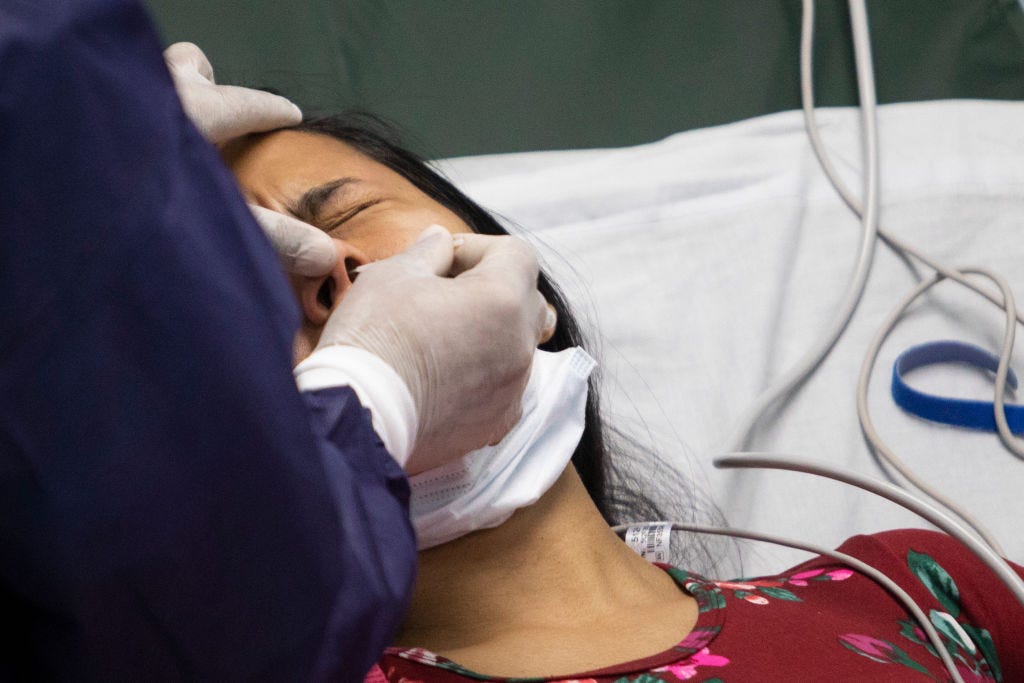
Getty
- A woman in her 40s is the first person known to experience brain fluid leakage after a COVID-19 nasal swab test.
- She had an undiagnosed skull defect, likely allowing the complication and other side effects, like sensitivity to light, to occur.
- For most people, a COVID-19 test is momentarily uncomfortable, but a minority report complications including severe pain and fainting.
- The study authors say the case demonstrates the importance of conducting COVID-19 tests safely, including by taking into account patients’ medical history.
- Visit Business Insider’s homepage for more stories.
A woman in her 40s is the first known person to have brain fluid leak into her nose after undergoing a nasal swab to test for COVID-19.
The woman had an undiagnosed skull defect that prevents the bones from completely closing, likely allowing the swab to prompt the symptoms, including a runny nose and headache.
The case, reported Thursday in the journal JAMA Otolaryngology—Head & Neck Surgery, brings attention to the importance of training clinicians and patients on how to conduct COVID tests safely, especially as testing is expected to ramp up to as many as 6 million a tests a day by the end of the year, the authors write.
The woman went to the hospital with a headache, runny nose, and other symptoms
The woman in the case study underwent a COVID-19 test while in the hospital for an elective surgery. Soon after, she developed a runny nose, headache, and vomiting.
By the time she went back to the hospital, she also complained of a metallic taste in her mouth, neck stiffness, and light sensitivity, the study reports.
Clinicians at the University of Iowa noted that 20 years earlier, she'd had a condition causing pressure in the brain and had nasal polyps removed.
They found the liquid coming from her nose tested positive for a marker of brain fluid, and a brain scan revealed she had an encephalocele, a rare condition in which the bones of the skull don't completely close.
Using past scans for comparison, it seemed she'd had the condition since at least 2017, though it had gone undiagnosed.
The doctors concluded that her COVID-19 test likely didn't cause the encephalocele itself, but rather aggravated it, allowing cerebrospinal fluid to leak out.
The woman underwent a surgery to repair her skull and, as of the writing of the case study, remained in the hospital to have the fluids safely drained and any potential neurological side effects monitored.

Courtesy of JAMA Network.
Other adverse but less severe reactions have been reported after nasal swabs for COVID-19
A nasal swab COVID test, or PCR test, detects whether the virus is currently in your body. It involves pushing a thin, plastic nasal swab three to four inches along the floor of the nose through the nostril.
The goal is to extract sputum — the material that gets ejected through coughing, sneezing, spitting, and singing — in order to test it for some of the coronavirus's genes.
For most, the procedure causes "a five- to eight-second shock of unpleasantness," Dr. Shawn Nasseri, an ear, nose, and throat surgeon in Los Angeles, previously told Business Insider. It can also come with some throat pain due to the swab reaching the throat or tonsils, or prompt people to sneeze.
But a minority of people have had worse reactions, with one survivor previously telling Insider it was "excruciating" and caused her to pass out.
That response, which can be preceded by pale skin, lightheadedness, tunnel vision, nausea, and clammy sweat, is likely due to a lack of blood flow to the brain, just like some people faint at the sight of blood.
The case and anecdotes highlight the importance of proper training before conducting COVID tests
In some cases, clinicians' experience (or lack thereof) can contribute to better (or worse) experiences getting tested.
"There is definitely a learning curve with the technique in terms of how much resistance one pushes against in the nose and therefore 'hurts' the patient," Nasseri previously told Business Insider. "It is similar to playing the 'Operation' game, but blindly as most clinical personnel swabbing the nose are doing it without seeing inside the nose."
On the other hand, inexperienced clinicians or patients themselves may not insert the swab far enough, in which case it may be more comfortable but less effective.
And, as the current case illustrates, even expertly performed COVID-19 tests can lead to complications if the patient has had any prior surgery or underlying condition that may have altered the structure and strength of their nasal passage or skull.
They say the findings underscore the importance of training clinicians and patients to perform COVID-19 tests safely, including checking medical history. Testing remains a critical strategy in defeating the coronavirus.
Patients can make the tests easier on themselves by trying to keep their facial muscles relaxed during the procedure.
"When we grimace or make a face, it actually tightens the nostrils and tends to force swabs up into the nose instead of along the floor of the nose," Nasseri said. "This definitely makes it more unpleasant for the patient."
Finally, if you have a history of fainting after, say, a blood draw or vaccine, make sure you're securely seated or lying down when given the test and wait at least 15 minutes afterward to get up.
